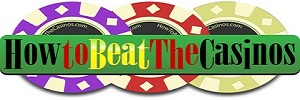Popular Casino Table Game Odds Comparison
I thought it might be useful to write an article comparing the many popular casino table games available (in both online and land-based casinos) and providing estimated odds for each game under usual casino conditions. Whether you’re a new casino player, or a casino player with years of experience, understanding the mathematical odds of each game (and knowing the “house edge”) can be beneficial.
Blackjack: Blackjack is a card game in which the goal is to have a hand value of 21 or as close to 21 as possible without going over. The game is played with one or more decks of 52 cards, and the value of a hand is determined by the sum of the point values of the individual cards. Face cards (Jack, Queen, and King) are worth 10 points, Aces are worth 1 or 11 points, and all other cards are worth their face value.
In a standard game of blackjack, the house has a slight advantage due to the fact that the player must act first. This means that if the player busts (goes over 21), the house wins even if the house subsequently busts as well. The house edge in blackjack can range from around 0.5% to 2%, depending on the specific rules of the game and the skill of the player.
Roulette: Roulette is a game of chance in which a ball is spun around a wheel with numbered slots, and players bet on where the ball will land. The wheel is divided into 38 slots, with 18 red, 18 black, and 2 green. The green slots represent 0 and 00, and if the ball lands in one of these slots, all bets on red, black, odd, even, etc. lose.
In roulette, the house edge is determined by the probability of a given outcome occurring. For example, the probability of the ball landing on a specific number is 1/38, so the odds of winning a bet on that number are 37/1. The house edge on a single number bet is therefore (37/1) * (1/38) = 5.26%. The house edge on other types of bets is lower, with even money bets (red/black, odd/even) having a house edge of 2.70%.
Craps: Craps is a dice game in which players make bets on the outcome of the roll, or a series of rolls, of a pair of dice. The basic premise of the game is simple: players bet on the outcome of the roll, and if the roll matches their bet, they win.
The house edge in craps varies depending on the specific bet being made. Some bets, such as betting on a specific number, have a high house edge, while other bets, such as the pass line bet, have a low house edge. The overall house edge in craps is around 1.4%, making it one of the better bets in the casino.
Baccarat: Baccarat is a card game played with a single deck of cards, or sometimes multiple decks. The goal of the game is to have a hand value as close to 9 as possible. In baccarat, face cards and 10s are worth 0 points, Aces are worth 1 point, and all other cards are worth their face value. The value of a hand is determined by the rightmost digit of the sum of the cards, so for example, a hand containing a 6 and 7 would be worth 3 points (6+7=13, and the rightmost digit is 3).
The house edge in baccarat varies depending on the specific bet being made. The house edge on the banker bet is 1.06%, while the player bet has a house edge of 1.24%. The tie bet, which pays 8:1, has a high house edge of 14.44%.
Tai Sai: Tai Sai, also known as sic bo, is a dice game played with three dice. Players bet on the outcome of the roll, or a series of rolls, and the payouts for each bet are determined by the probability of the chosen outcome occurring.
The house edge in tai sai varies depending on the specific bet being made. Some bets, such as betting on the total sum of the dice, have a lower house edge, while other bets, such as betting on specific numbers, have a higher house edge. The overall house edge in tai sai is around 2.78%.
Pai Gow Tiles: Pai gow tiles is a game played with a set of 32 Chinese dominoes. The goal of the game is to create two hands, a “high” hand and a “low” hand, that are ranked higher than the corresponding hands of the dealer.
The house edge in pai gow tiles depends on the specific rules of the game and the skill of the player. According to one estimate, the house edge for a player who uses the “house way” strategy (which is the recommended strategy for novice players) is around 2.7%. However, skilled players can potentially reduce the house edge to around 1.5% by using a more advanced strategy.
Three Card Stud: Three card stud is a card game played with a standard deck of 52 cards. In this game, each player is dealt three cards, and the goal is to create the highest ranked poker hand using these three cards. The rank of poker hands from highest to lowest is as follows: straight flush, three of a kind, straight, flush, pair, and high card.
The house edge in three card stud depends on the specific rules of the game and the skill of the player. In a standard game of three card stud, the house edge is around 3.37%. However, if the game includes an optional side bet, such as a “pair plus” bet, the house edge may be higher.
Caribbean Stud Poker with Progressives: Caribbean stud poker is a card game played with a standard deck of 52 cards. In this game, each player is dealt five cards, and the goal is to create the highest ranked poker hand using these five cards. The rank of poker hands is the same as in three card stud.
In Caribbean stud poker with progressives, there is an optional side bet that allows players to win a progressive jackpot if they achieve certain hand ranks, such as a royal flush. The size of the progressive jackpot increases as more players make the side bet, but the probability of winning the jackpot is very low.
The house edge in Caribbean stud poker with progressives depends on the specific rules of the game and the size of the progressive jackpot. In a standard game of Caribbean stud poker without a progressive jackpot, the house edge is around 5.22%. However, the inclusion of a progressive jackpot increases the house edge, as the casino must take a cut of the jackpot to cover its costs.
I hope you’ve enjoyed my brief guide to the various casino table games that are available, and their odds.

